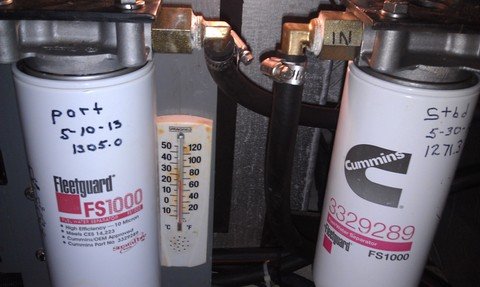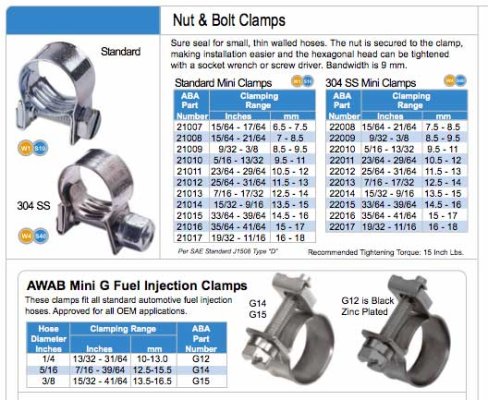timjet
Guru
- Joined
- Apr 9, 2009
- Messages
- 1,920
I have had a fuel issue since I bought the boat several years ago. The problem is inconsistant and difficult to predict.
I have 3 fuel tanks, Port saddle tank that feeds the port engine and generator. Stbd saddle tank that feeds only the stbd engine. Aux tank that has two feeds, to either the port or stbd engine either one or both engines.
The boat also has installed a pump that can transfer fuel from the port to starboard engine and vis a versa, presumably to balance the tank after generator usage.
So here's the problem. It seems both engines rpm start to decay when fuel in any tank gets below about half full. I've checked all the filters and they are good. On one cruise we were feeding both engines from the aux tank and when it was about half full the port engine rpm started to decay from 2300 to 2000 rpm. I switched port engine feed to it's full saddle tank and the engine rpm came back to normal. 20 minutes later the same thing happened to the starboard engine and it's rpm came back after switching to it's full saddle tank. The same thing happens when the saddle tanks get below half full.
The last time we were out I was feeding from the aux tank which was only about a third full. We were cruising at 1400 rpm and suddenly the engine quit. I switched to it's saddle tank, and it came back.
However, I have not filled the aux tank and just for grins at the dock I started both engines and feed them both from the aux tank, no problems. I didn't go above idle.
Anyway as I said the problem is somewhat inconsistent. I have been told to check for air leaks and I am beginning to suspect the several elbows around the Racor and another filter I have before fuel gets to the engine filter. These elbows can't be tighten or they will not point in the proper direction. Last week I replaced the fuel lines with new, I was told to do that too, 17 yo boat. Tomorrow I'm going down to the boat and using a hand vacuum pump put 5" HG on the entire system to see if I can track down the air leak, if that what it is. If I notice a drop in vacuum, I'm not sure how I can find the leak, since it's a vacuum and no fuel will come out.
Anyway as I said before I suspect the several elbows and may replace them with swivel elbow fittings that will allow me to tighten them securely, at least eliminating these as the issue. Anybody know where to get these elbows? Any other comments about this are appreciated.
Below is a picture of the current installation with an elbow on each side of the filter head. They must point down and so are not particularity tight.
I have 3 fuel tanks, Port saddle tank that feeds the port engine and generator. Stbd saddle tank that feeds only the stbd engine. Aux tank that has two feeds, to either the port or stbd engine either one or both engines.
The boat also has installed a pump that can transfer fuel from the port to starboard engine and vis a versa, presumably to balance the tank after generator usage.
So here's the problem. It seems both engines rpm start to decay when fuel in any tank gets below about half full. I've checked all the filters and they are good. On one cruise we were feeding both engines from the aux tank and when it was about half full the port engine rpm started to decay from 2300 to 2000 rpm. I switched port engine feed to it's full saddle tank and the engine rpm came back to normal. 20 minutes later the same thing happened to the starboard engine and it's rpm came back after switching to it's full saddle tank. The same thing happens when the saddle tanks get below half full.
The last time we were out I was feeding from the aux tank which was only about a third full. We were cruising at 1400 rpm and suddenly the engine quit. I switched to it's saddle tank, and it came back.
However, I have not filled the aux tank and just for grins at the dock I started both engines and feed them both from the aux tank, no problems. I didn't go above idle.
Anyway as I said the problem is somewhat inconsistent. I have been told to check for air leaks and I am beginning to suspect the several elbows around the Racor and another filter I have before fuel gets to the engine filter. These elbows can't be tighten or they will not point in the proper direction. Last week I replaced the fuel lines with new, I was told to do that too, 17 yo boat. Tomorrow I'm going down to the boat and using a hand vacuum pump put 5" HG on the entire system to see if I can track down the air leak, if that what it is. If I notice a drop in vacuum, I'm not sure how I can find the leak, since it's a vacuum and no fuel will come out.
Anyway as I said before I suspect the several elbows and may replace them with swivel elbow fittings that will allow me to tighten them securely, at least eliminating these as the issue. Anybody know where to get these elbows? Any other comments about this are appreciated.
Below is a picture of the current installation with an elbow on each side of the filter head. They must point down and so are not particularity tight.
Attachments
Last edited:



